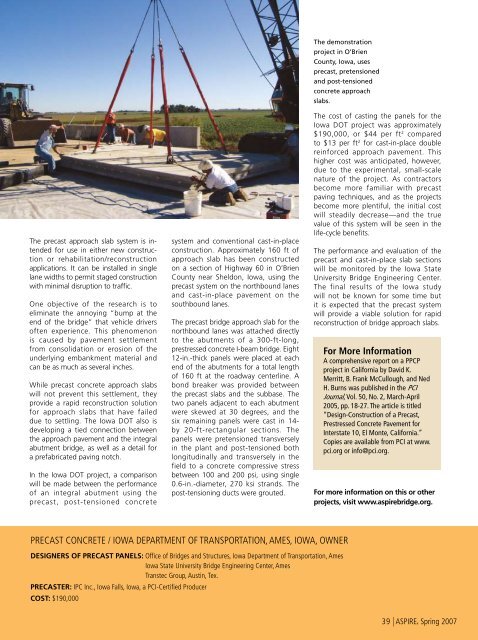ASPIRE Spring 07 - Aspire - The Concrete Bridge Magazine
ASPIRE Spring 07 - Aspire - The Concrete Bridge Magazine
ASPIRE Spring 07 - Aspire - The Concrete Bridge Magazine
You also want an ePaper? Increase the reach of your titles
YUMPU automatically turns print PDFs into web optimized ePapers that Google loves.
<strong>The</strong> precast approach slab system is intended<br />
for use in either new construction<br />
or rehabilitation/reconstruction<br />
applications. It can be installed in single<br />
lane widths to permit staged construction<br />
with minimal disruption to traffic.<br />
One objective of the research is to<br />
eliminate the annoying “bump at the<br />
end of the bridge” that vehicle drivers<br />
often experience. This phenomenon<br />
is caused by pavement settlement<br />
from consolidation or erosion of the<br />
underlying embankment material and<br />
can be as much as several inches.<br />
While precast concrete approach slabs<br />
will not prevent this settlement, they<br />
provide a rapid reconstruction solution<br />
for approach slabs that have failed<br />
due to settling. <strong>The</strong> Iowa DOT also is<br />
developing a tied connection between<br />
the approach pavement and the integral<br />
abutment bridge, as well as a detail for<br />
a prefabricated paving notch.<br />
In the Iowa DOT project, a comparison<br />
will be made between the performance<br />
of an integral abutment using the<br />
precast, post-tensioned concrete<br />
system and conventional cast-in-place<br />
construction. Approximately 160 ft of<br />
approach slab has been constructed<br />
on a section of Highway 60 in O’Brien<br />
County near Sheldon, Iowa, using the<br />
precast system on the northbound lanes<br />
and cast-in-place pavement on the<br />
southbound lanes.<br />
<strong>The</strong> precast bridge approach slab for the<br />
northbound lanes was attached directly<br />
to the abutments of a 300-ft-long,<br />
prestressed concrete I-beam bridge. Eight<br />
12-in.-thick panels were placed at each<br />
end of the abutments for a total length<br />
of 160 ft at the roadway centerline. A<br />
bond breaker was provided between<br />
the precast slabs and the subbase. <strong>The</strong><br />
two panels adjacent to each abutment<br />
were skewed at 30 degrees, and the<br />
six remaining panels were cast in 14-<br />
by 20-ft-rectangular sections. <strong>The</strong><br />
panels were pretensioned transversely<br />
in the plant and post-tensioned both<br />
longitudinally and transversely in the<br />
field to a concrete compressive stress<br />
between 100 and 200 psi, using single<br />
0.6-in.-diameter, 270 ksi strands. <strong>The</strong><br />
post-tensioning ducts were grouted.<br />
<strong>The</strong> demonstration<br />
project in O’Brien<br />
County, Iowa, uses<br />
precast, pretensioned<br />
and post-tensioned<br />
concrete approach<br />
slabs.<br />
<strong>The</strong> cost of casting the panels for the<br />
Iowa DOT project was approximately<br />
$190,000, or $44 per ft 2 compared<br />
to $13 per ft 2 for cast-in-place double<br />
reinforced approach pavement. This<br />
higher cost was anticipated, however,<br />
due to the experimental, small-scale<br />
nature of the project. As contractors<br />
become more familiar with precast<br />
paving techniques, and as the projects<br />
become more plentiful, the initial cost<br />
will steadily decrease—and the true<br />
value of this system will be seen in the<br />
life-cycle benefits.<br />
<strong>The</strong> performance and evaluation of the<br />
precast and cast-in-place slab sections<br />
will be monitored by the Iowa State<br />
University <strong>Bridge</strong> Engineering Center.<br />
<strong>The</strong> final results of the Iowa study<br />
will not be known for some time but<br />
it is expected that the precast system<br />
will provide a viable solution for rapid<br />
reconstruction of bridge approach slabs.<br />
For More Information<br />
A comprehensive report on a PPCP<br />
project in California by David K.<br />
Merritt, B. Frank McCullough, and Ned<br />
H. Burns was published in the PCI<br />
Journal, Vol. 50, No. 2, March-April<br />
2005, pp. 18-27. <strong>The</strong> article is titled<br />
“Design-Construction of a Precast,<br />
Prestressed <strong>Concrete</strong> Pavement for<br />
Interstate 10, El Monte, California.”<br />
Copies are available from PCI at www.<br />
pci.org or info@pci.org.<br />
For more information on this or other<br />
projects, visit www.aspirebridge.org.<br />
PRECAST concrete / IOWA DEPARTMENT OF TRANSPORTATION, AMES, IOWA, Owner<br />
Designers of Precast Panels: Office of <strong>Bridge</strong>s and Structures, Iowa Department of Transportation, Ames<br />
Iowa State University <strong>Bridge</strong> Engineering Center, Ames<br />
Transtec Group, Austin, Tex.<br />
Precaster: IPC Inc., Iowa Falls, Iowa, a PCI-Certified Producer<br />
Cost: $190,000<br />
39 | <strong>ASPIRE</strong>, <strong>Spring</strong> 20<strong>07</strong>

















